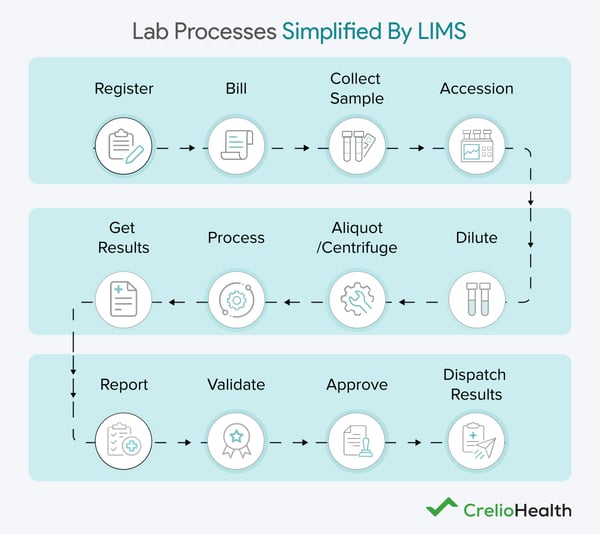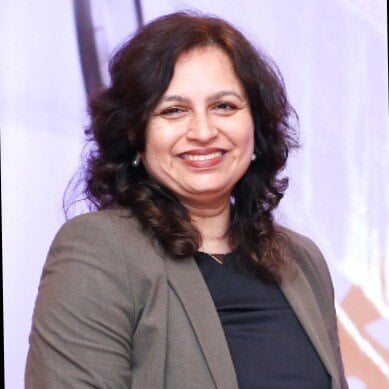April 24, 2023
 by Kedar Kulkarni / April 24, 2023
by Kedar Kulkarni / April 24, 2023

Digitization is turning healthcare upside down.
Better-informed and more demanding consumers expect improved patient care services that is reliable, fast, and affordable. However, with a 26% global shortage of healthcare professionals and forecasts of further increase by 2030, streamlining processes and increasing efficiencies are essential to meet the market's growing demands.
One way for healthcare professionals to improve patient care is by adopting a laboratory information management system (LIMS). This modern technology enhances lab workflows, tackles manual work, and minimizes unnecessary expenses.
A laboratory information management system (LIMS) is a software solution that provides efficient laboratory administration, test execution, and quality control for every type of lab.
It’s a critical component of laboratory operations, responsible for managing and organizing a huge amount of data generated in a laboratory environment.
A reliable LIMS streamlines lab workflows from registration, sample collection, and payments to sample management and report delivery using faster, error-free data and by automating mundane processes.
Let's examine LIMS capabilities with a typical sample testing workflow.

Source: Creliohealth
Labs typically face a lack of process standardization, insufficient information about patients and tests, unreliable communication, patient waiting times, and data protection issues during registration.
LIMS streamlines the process by managing patient information, reducing the time and effort required to enroll new patients and access patient information.
Here are some ways LIMS helps with patient registration.
Sample management is tricky, and many factors can affect the process' accuracy and efficiency. Up to 30% of samples are lost or misidentified due to a lack of trained staff.
Additionally, manual tracking processes and inadequate information management systems significantly increase the turnaround time (TAT). Improper sample handling is also a common problem, with many samples being compromised due to improper storage and handling.
To mitigate these challenges, labs need to invest in effective sample management strategies. How does LIMS fit into the picture?
LIMS is capable of managing all aspects of the sample lifecycle.
Labs often struggle with data management, accuracy, time constraints, technical customization, result interpretation, and regulatory compliance in reporting. Effective reporting requires proper planning, qualified staff, and the right tools.
LIMS saves the day when streamlining and organizing reporting.
LIMS offers multiple benefits for clinical, research, and industrial laboratories.

Source: Creliohealth
LIMS automates and streamlines processes, helping manage samples, patient data, results, inventory, and other lab data in one place. Unified management enables lab technicians and clinicians to easily access and share information.
With its real-time overview of the testing process, LIMS optimizes the turnaround time for diagnostic tests. It automates several testing steps, including sample preparation, data analysis, and report generation, reducing the time to complete each test.
LIMS connects with multiple machines and instruments employed in diagnostic labs for effortless data transfer. This eliminates manual data entry and minimizes the chances of errors, ultimately enhancing accuracy and efficiency.
By automating administrative tasks like sample tracking, data entry, and report delivery, LIMS reduces the risk of errors and saves precious time for lab staff. This improves the quality of services and alleviates the administrative burden on lab admins.
LIMS optimizes sample management, ensuring efficient and accurate handling of each sample and reducing the risk of lost or misplaced samples, wastage, and rework.
LIMS standardizes and simplifies quality assurance (QA) and quality control (QC) processes. It further automates data QC by evaluating the results of control samples, calibration records, and instrument performance data, providing accurate and reliable laboratory results.
LIMS helps diagnostic labs minimize compliance time and costs by ensuring adherence to regulatory requirements and automating compliance-related tasks, such as data management, reporting, and sample management.
With advances in technology and demand for streamlined laboratory processes, different types of LIMS are now available on the market. Each is tailored to the specific needs and requirements of varied laboratory environments.
This type of LIMS is installed and run on a single computer. It’s ideal for small labs that generate limited data. A standalone LIMS is often the simplest and least expensive option but may not have the capacity to handle large amounts of data or multiple users.
Client-server LIMS uses a central server to store, retrieve, and analyze the data. It works best for large labs and organizations that generate large amounts of data. The centralized server provides a single place to store and access data, simplifying management and maintenance.
The web-based LIMS uses a web browser as an interface to access the system from anywhere. It’s ideal for organizations with multiple remote labs or users who need to access data from different locations. The web-based LIMS enables secure remote access to data and saves users from installing software on their local computers.
Cloud-based LIMS is hosted on remote servers and provides access to the system over the internet. It’s ideal for organizations that don't want to invest in hardware and software to run the system internally.
Cloud-based LIMS is often the most cost-effective option, as the hosting provider manages the infrastructure and software updates. Thanks to its flexibility, scalability, and faster services, it’s widely deployed worldwide, with a 30% market share expected by 2033.
The LIMS you choose depends on your specific needs – the amount of data you generate, the number of users, and your lab's location. Each LIMS has its unique strengths and weaknesses. Regardless of the type you choose, make sure it's flexible, scalable, and reliable to meet your changing needs.
LIMS is one of the unique digital transformations of the 21st century, specifically designed for the otherwise inherently traditional healthcare industry. It streamlines lab workflows, drives precision and growth, and provides better patient care while reducing costs.
Despite the ongoing debate between man and machine, a thorough understanding of the rapidly evolving and demanding healthcare market underpins LIMS as a crucial tool for laboratories.
Want to create a smarter healthcare practice but not sure where to begin? Learn about the benefits, myths, and limitations of AI in healthcare and how this cutting-edge technology is transforming the industry.
As a content writer at CrelioHealth, Kedar has been dedicated to producing healthcare content for more than two years. He has a deep understanding of the healthcare industry, which reflects in his writing style. In addition to his passion for writing, Kedar loves movies, poetry, languages, and philosophy. In his spare time, he enjoys learning more about different cultures and listening to music.
In the world of laboratories, precision and efficiency are absolute essentials. Yet, inventory...
 by Shonali Paul
by Shonali Paul
As a civil engineering student, I loved environmental sciences. We spent a lot of time...
.png) by Devyani Mehta
by Devyani Mehta
No matter your industry, demonstrating your lab's reliability and ability to comply with...
 by Nicholas Evans
by Nicholas Evans
In the world of laboratories, precision and efficiency are absolute essentials. Yet, inventory...
 by Shonali Paul
by Shonali Paul
As a civil engineering student, I loved environmental sciences. We spent a lot of time...
.png) by Devyani Mehta
by Devyani Mehta


